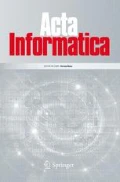Summary
Dijkstra has given a derivation of an efficient algorithm for a problem concerning monotonic subsequences, and extracted a proof of a related theorem from the algorithm. Here it is shown that a careful separation of concerns can lead to a beautiful conventional proof, a very different derivation of Dijkstra's algorithm, a more elegant proof from the algorithm, and the discovery of a duality property.
Similar content being viewed by others
References
Dijkstra, E.W.: Some beautiful arguments using mathematical induction. Acta Informat. 13, 1–8 (1980)
Dijkstra, E.W.: A discipline of programming. Englewood Cliffs, N.J.: Prentice-Hall 1976
Fredman, M.L.: On computing the length of longest increasing subsequences. Discrete Math. 11, 29–35 (1975)
Seidenburg, A.: A simple proof of a theorem of Erdös and Szekeres. J. London Math. Soc. 34, 352 (1959)
Author information
Authors and Affiliations
Rights and permissions
About this article
Cite this article
Pritchard, P. Another look at the “longest ascending subsequence” problem. Acta Informatica 16, 87–91 (1981). https://doi.org/10.1007/BF00289592
Received:
Revised:
Issue Date:
DOI: https://doi.org/10.1007/BF00289592




